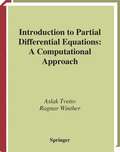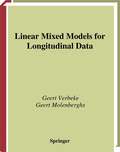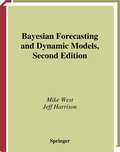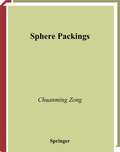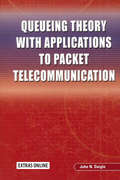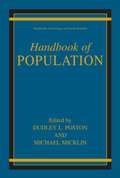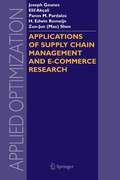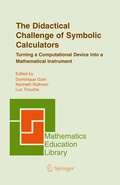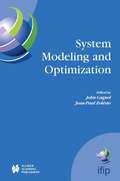- Table View
- List View
Introduction to Partial Differential Equations: A Computational Approach (Texts in Applied Mathematics #29)
by Aslak Tveito Ragnar WintherCombining both the classical theory and numerical techniques for partial differential equations, this thoroughly modern approach shows the significance of computations in PDEs and illustrates the strong interaction between mathematical theory and the development of numerical methods. Great care has been taken throughout the book to seek a sound balance between these techniques. The authors present the material at an easy pace and exercises ranging from the straightforward to the challenging have been included. In addition there are some "projects" suggested, either to refresh the students memory of results needed in this course, or to extend the theories developed in the text. Suitable for undergraduate and graduate students in mathematics and engineering.
Determinants and Their Applications in Mathematical Physics (Applied Mathematical Sciences #134)
by Robert Vein Paul DaleA unique and detailed account of all important relations in the analytic theory of determinants, from the classical work of Laplace, Cauchy and Jacobi to the latest 20th century developments. The first five chapters are purely mathematical in nature and make extensive use of the column vector notation and scaled cofactors. They contain a number of important relations involving derivatives which prove beyond a doubt that the theory of determinants has emerged from the confines of classical algebra into the brighter world of analysis. Chapter 6 is devoted to the verifications of the known determinantal solutions of several nonlinear equations which arise in three branches of mathematical physics, namely lattice, soliton and relativity theory. The solutions are verified by applying theorems established in earlier chapters, and the book ends with an extensive bibliography and index. Several contributions have never been published before. Indispensable for mathematicians, physicists and engineers wishing to become acquainted with this topic.
Linear Mixed Models for Longitudinal Data (Springer Series in Statistics)
by Geert Verbeke Geert MolenberghsThis book provides a comprehensive treatment of linear mixed models for continuous longitudinal data. Next to model formulation, this edition puts major emphasis on exploratory data analysis for all aspects of the model, such as the marginal model, subject-specific profiles, and residual covariance structure. Further, model diagnostics and missing data receive extensive treatment. Sensitivity analysis for incomplete data is given a prominent place.Most analyses were done with the MIXED procedure of the SAS software package, but the data analyses are presented in a software-independent fashion.
Bayesian Forecasting and Dynamic Models (Springer Series in Statistics)
by Mike West Jeff HarrisonThis text is concerned with Bayesian learning, inference and forecasting in dynamic environments. We describe the structure and theory of classes of dynamic models and their uses in forecasting and time series analysis. The principles, models and methods of Bayesian forecasting and time - ries analysis have been developed extensively during the last thirty years. Thisdevelopmenthasinvolvedthoroughinvestigationofmathematicaland statistical aspects of forecasting models and related techniques. With this has come experience with applications in a variety of areas in commercial, industrial, scienti?c, and socio-economic ?elds. Much of the technical - velopment has been driven by the needs of forecasting practitioners and applied researchers. As a result, there now exists a relatively complete statistical and mathematical framework, presented and illustrated here. In writing and revising this book, our primary goals have been to present a reasonably comprehensive view of Bayesian ideas and methods in m- elling and forecasting, particularly to provide a solid reference source for advanced university students and research workers.
Weyl Transforms (Universitext)
by M.W. WongA study of the functional analytic properties of Weyl transforms as bounded linear operators on $ L2ü(äBbb Rünü) $ in terms of the symbols of the transforms. Further, the boundedness, the compactness, the spectrum and the functional calculus of the Weyl transform are proved in detail, while new results and techniques on the boundedness and compactness of the Weyl transforms in terms of the symbols in $ Lrü(äBbb Rü2nü) $ and in terms of the Wigner transforms of Hermite functions are given. The roles of the Heisenberg group and the symplectic group in the study of the structure of the Weyl transform are explained, and the connections of the Weyl transform with quantization are highlighted throughout the book. Localisation operators, first studied as filters in signal analysis, are shown to be Weyl transforms with symbols expressed in terms of the admissible wavelets of the localisation operators. The results and methods mean this book is of interest to graduates and mathematicians working in Fourier analysis, operator theory, pseudo-differential operators and mathematical physics.
Sphere Packings (Universitext)
by Chuanming ZongSphere packings is one of the most fascinating and challenging subjects in mathematics. In the course of centuries, many exciting results have been obtained, ingenious methods created, related challenging problems proposed, and many surprising connections with other subjects found. This book gives a full account of this fascinating subject, especially its local aspects, discrete aspects, and its proof methods. The book includes both classical and contemporary results and provides a full treatment of the subject.
Tutorials on Emerging Methodologies and Applications in Operations Research: Presented at INFORMS 2004, Denver, CO (International Series in Operations Research & Management Science #76)
by Harvey J. GreenbergThis volume reflects the theme of the INFORMS 2004 Meeting in Denver: Back to OR Roots. Emerging as a quantitative approach to problem-solving in World War II, our founders were physicists, mathematicians, and engineers who quickly found peace-time uses. It is fair to say that Operations Research (OR) was born in the same incubator as computer science, and it has spawned many new disciplines, such as systems engineering, health care management, and transportation science. Although people from many disciplines routinely use OR methods, many scientific researchers, engineers, and others do not understand basic OR tools and how they can help them. Disciplines ranging from finance to bioengineering are the beneficiaries of what we do — we take an interdisciplinary approach to problem-solving. Our strengths are modeling, analysis, and algorithm design. We provide a quanti- tive foundation for a broad spectrum of problems, from economics to medicine, from environmental control to sports, from e-commerce to computational - ometry. We are both producers and consumers because the mainstream of OR is in the interfaces. As part of this effort to recognize and extend OR roots in future probl- solving, we organized a set of tutorials designed for people who heard of the topic and want to decide whether to learn it. The 90 minutes was spent addre- ing the questions: What is this about, in a nutshell? Why is it important? Where can I learn more? In total, we had 14 tutorials, and eight of them are published here.
Queueing Theory with Applications to Packet Telecommunication
by John DaigleQueueing Theory with Applications to Packet Telecommunication is an efficient introduction to fundamental concepts and principles underlying the behavior of queueing systems and its application to the design of packet-oriented electrical communication systems. In addition to techniques and approaches found in earlier works, the author presents a thoroughly modern computational approach based on Schur decomposition. This approach facilitates solution of broad classes of problems wherein a number of practical modeling issues may be explored. Key features of communication systems, such as correlation in packet arrival processes at IP switches and variability in service rates due to fading wireless links are introduced. Numerous exercises embedded within the text and problems at the end of certain chapters that integrate lessons learned across multiple sections are also included. In all cases, including systems having priority, developments lead to procedures or formulae that yield numerical results from which sensitivity of queueing behavior to parameter variation can be explored. In several cases multiple approaches to computing distributions are presented. Queueing Theory with Applications to Packet Telecommunication is intended both for self study and for use as a primary text in graduate courses in queueing theory in electrical engineering, computer science, operations research, and mathematics. Professionals will also find this work invaluable because the author discusses applications such as statistical multiplexing, IP switch design, and wireless communication systems. In addition, numerous modeling issues, such as the suitability of Erlang-k and Pade approximations are addressed.
Dynamics in Infinite Dimensions (Applied Mathematical Sciences #47)
by Jack K. Hale Luis T. Magalhaes Waldyr OlivaState-of-the-art in qualitative theory of functional differential equations; Most of the new material has never appeared in book form and some not even in papers; Second edition updated with new topics and results; Methods discussed will apply to other equations and applications
Uncertainty in the Electric Power Industry: Methods and Models for Decision Support (International Series in Operations Research & Management Science #77)
by Christoph WeberAround the world, liberalization and privatization in the electricity industry have lead to increased competition among utilities. At the same time, utilities are now exposed more than ever to risk and uncertainties, which they cannot pass on to their customers through price increases as in a regulated environment. Especially electricity-generating companies have to face volatile wholesale prices, fuel price uncertainty, limited long-term hedging possibilities and huge, to a large extent, sunk investments. In this context, Uncertainty in the Electric Power Industry: Methods and Models for Decision Support aims at an integrative view on the decision problems that power companies have to tackle. It systematically examines the uncertainties power companies are facing and develops models to describe them - including an innovative approach combining fundamental and finance models for price modeling. The optimization of generation and trading portfolios under uncertainty is discussed with particular focus on CHP and is linked to risk management. Here the concept of integral earnings at risk is developed to provide a theoretically sound combination of value at risk and profit at risk approaches, adapted to real market structures and market liquidity. Also methods for supporting long-term investment decisions are presented: technology assessment based on experience curves and operation simulation for fuel cells and a real options approach with endogenous electricity prices.
Multiple Criteria Decision Analysis: State of the Art Surveys (International Series in Operations Research & Management Science #78)
by Salvatore GrecoMultiple Criteria Decision Analysis: State of the Art Surveys provides survey articles and references of the seminal or state-of-the-art research on MCDA. The material covered ranges from the foundations of MCDA, over various MCDA methodologies (outranking methods, multiattribute utility and value theories, non-classical approaches) to multiobjective mathematical programming, MCDA applications, and software. This vast amount of material is organized in 8 parts, with a total of 25 chapters. More than 2000 references are listed.
Handbook of Population (Handbooks of Sociology and Social Research)
by Dudley L. Poston Michael MicklinThis comprehensive handbook provides an overview and update of the issues, theories, processes, and applications of the social science of population studies. The volume's 30 chapters cover the full range of conceptual, empirical, disciplinary, and applied approaches to the study of demographic phenomena. This book is the first effort to assess the entire field since Hauser and Duncan's 1959 classic, The Study of Population. The chapter authors are among the leading contributors to demographic scholarship over the past four decades. They represent a variety of disciplines and theoretical perspectives as well as interests in both basic and applied research.
Singular Perturbation Theory: Mathematical and Analytical Techniques with Applications to Engineering (Mathematical and Analytical Techniques with Applications to Engineering)
by R.S. JohnsonThe importance of mathematics in the study of problems arising from the real world, and the increasing success with which it has been used to model situations ranging from the purely deterministic to the stochastic, is well established. The purpose of the set of volumes to which the present one belongs is to make available authoritative, up to date, and self-contained accounts of some of the most important and useful of these analytical approaches and techniques. Each volume provides a detailed introduction to a specific subject area of current importance that is summarized below, and then goes beyond this by reviewing recent contributions, and so serving as a valuable reference source. The progress in applicable mathematics has been brought about by the extension and development of many important analytical approaches and techniques, in areas both old and new, frequently aided by the use of computers without which the solution of realistic problems would otherwise have been impossible.
Inverse Problems: Mathematical and Analytical Techniques with Applications to Engineering (Mathematical and Analytical Techniques with Applications to Engineering)
by Alexander G. RammInverse Problems is a monograph which contains a self-contained presentation of the theory of several major inverse problems and the closely related results from the theory of ill-posed problems. The book is aimed at a large audience which include graduate students and researchers in mathematical, physical, and engineering sciences and in the area of numerical analysis.
QoS in Packet Networks (The Springer International Series in Engineering and Computer Science #779)
by Kun I. ParkQoS is an important subject which occupies a central place in overall packet network technologies. A complex subject, its analysis involves such mathematical disciplines as probability, random variables, stochastic processes and queuing. These mathematical subjects are abstract, not easy to grasp for uninitiated persons. QoS in Packet Networks is written with two objectives. The first explains the fundamental mathematical concepts used in QoS analysis as plainly as possible, in layman's terms to afford the reader a better appreciation of the subject of QoS treated in this book. The second explains in plain language, the various parts of QoS in packet networks, to provide the reader with a complete view of this complex and dynamic area of communications networking technology. Discussion of the functional requirements of the packet networks to provide QoS is included.
Applications of Supply Chain Management and E-Commerce Research (Applied Optimization #92)
by Joseph Geunes Elif Akçali Panos M. Pardalos Zuo-Jun Max Shen H. Edwin RomeijnIn February 2002, the Industrial and Systems Engineering (ISE) De partment at the University of Florida hosted a National Science Founda tion Workshop on Collaboration and Negotiation in Supply Chain Man agement and E Commerce. This workshop focused on characterizing the challenges facing leading edge firms in supply chain management and electronic commerce, and identifying research opportunities for de veloping new technological and decision support capabilities sought by industry. The audience included practitioners in the areas of supply chain management and E Commerce, as well as academic researchers working in these areas. The workshop provided a unique setting that has facilitated ongoing dialog between academic researchers and industry practitioners. This book codifies many of the important themes and issues around which the workshop discussions centered. The editors of this book, all faculty members in the ISE Department at the University of Florida, also served as the workshop's coordinators. In addition to workshop participants, we also invited contributions from leading academics and practitioners who were not able to attend. As a result, the chapters herein represent a collection of research contributions, monographs, and case studies from a variety of disciplines and viewpoints. On the aca demic side alone, chapter authors include faculty members in supply chain and operations management, marketing, industrial engineering, economics, computer science, civil and environmental engineering, and building construction departments.
Handbook of Generalized Convexity and Generalized Monotonicity (Nonconvex Optimization and Its Applications #76)
by Nicolas Hadjisavvas Sándor Komlósi Siegfried S. SchaibleStudies in generalized convexity and generalized monotonicity have significantly increased during the last two decades. Researchers with very diverse backgrounds such as mathematical programming, optimization theory, convex analysis, nonlinear analysis, nonsmooth analysis, linear algebra, probability theory, variational inequalities, game theory, economic theory, engineering, management science, equilibrium analysis, for example are attracted to this fast growing field of study. Such enormous research activity is partially due to the discovery of a rich, elegant and deep theory which provides a basis for interesting existing and potential applications in different disciplines. The handbook offers an advanced and broad overview of the current state of the field. It contains fourteen chapters written by the leading experts on the respective subject; eight on generalized convexity and the remaining six on generalized monotonicity.
Recent Advances in Applied Probability
by Ricardo Baeza-Yates Joseph Glaz Henryk Gzyl Jürg Hüsler José Luis PalaciosApplied probability is a broad research area that is of interest to scientists in diverse disciplines in science and technology, including: anthropology, biology, communication theory, economics, epidemiology, finance, geography, linguistics, medicine, meteorology, operations research, psychology, quality control, sociology, and statistics. Recent Advances in Applied Probability is a collection of survey articles that bring together the work of leading researchers in applied probability to present current research advances in this important area. This volume will be of interest to graduate students and researchers whose research is closely connected to probability modelling and their applications. It is suitable for one semester graduate level research seminar in applied probability.
The Didactical Challenge of Symbolic Calculators: Turning a Computational Device into a Mathematical Instrument (Mathematics Education Library #36)
by Dominique Guin Kenneth Ruthven Luc TroucheA significant driver of recent growth in the use of mathematics in the professions has been the support brought by new technologies. Not only has this facilitated the application of established methods of mathematical and statistical analysis but it has stimulated the development of innovative approaches. These changes have produced a marked evolution in the professional practice of mathematics, an evolution which has not yet provoked a corresponding adaptation in mathematical education, particularly at school level. In particular, although calculators -- first arithmetic and scientific, then graphic, now symbolic -- have been found well suited in many respects to the working conditions of pupils and teachers, and have even achieved a degree of official recognition, the integration of new technologies into the mathematical practice of schools remains marginal. It is this situation which has motivated the research and development work to be reported in this volume. The appearance of ever more powerful and portable computational tools has certainly given rise to continuing research and development activity at all levels of mathematical education. Amongst pioneers, such innovation has often been seen as an opportunity to renew the teaching and learning of mathematics. Equally, however, the institutionalization of computational tools within educational practice has proceeded at a strikingly slow pace over many years.
System Modeling and Optimization: Proceedings of the 21st IFIP TC7 Conference held in July 21st - 25th, 2003, Sophia Antipolis, France (IFIP Advances in Information and Communication Technology #166)
by Jean-Paul Zolesio John CagnolSystem Modeling and Optimization is an indispensable reference for anyone interested in the recent advances in these two disciplines. The book collects, for the first time, selected articles from the 21st and most recent IFIP TC 7 conference in Sophia Antipolis, France. Applied mathematicians and computer scientists can attest to the ever-growing influence of these two subjects. The practical applications of system modeling and optimization can be seen in a number of fields: environmental science, transport and telecommunications, image analysis, free boundary problems, bioscience, and non-cylindrical evolution control, to name just a few. New developments in each of these fields have contributed to a more complex understanding of both system modeling and optimization. Editors John Cagnol and Jean-Paul Zolésio, chairs of the conference, have assembled System Modeling and Optimization to present the most up-to-date developments to professionals and academics alike.
Encyclopedia of Cryptography and Security
by Henk C. A. Van TilborgThis comprehensive encyclopedia provides easy access to information on all aspects of cryptography and security. With an A–Z format of over 460 entries, 100+ international experts provide an accessible reference for those seeking entry into any aspect of the broad fields of cryptography and information security. Most entries in this preeminent work include useful literature references, providing more than 2500 references in total. Topics for the encyclopedia were selected by a distinguished advisory board consisting of 18 of the world’s leading scholars and practitioners. Main subject areas include: Authentication and identification.- Block ciphers and stream ciphers.- Computational issues.- Copy protection.- Cryptanalysis and security.- Cryptographic protocols.- Electronic payment and digital certificates.- Elliptic curve cryptography.- Factorization algorithms and primality tests.- Hash functions and MACs.- Historical systems.- Identity-based cryptography.- Implementation aspects for smart cards and standards.- Key management.- Multiparty computations like voting schemes.- Public key cryptography.- Quantum cryptography.- Secret sharing schemes.- Sequences.- Web security. The style of the entries in the Encyclopedia of Cryptography and Security is expository and tutorial rather than detailed and technical, making the book a practical resource for information security experts as well as professionals in other fields who need to access this vital information but who may not have time to work their way through an entire text on their topic of interest. The underlying concepts in information security can be difficult to understand and may even be counter-intuitive. The Encyclopedia of Cryptography and Security will become the premier reference work on this complex subject.
Online Storage Systems and Transportation Problems with Applications: Optimization Models and Mathematical Solutions (Applied Optimization #91)
by Julia KallrathAppendices A Rotastore A. l Tabular Results for Different Models A. 2 Tabular Results for Different Algorithms B OptiTrans B. l Input Data B. l. l Input Data Common to all Solution Approaches B. 1. 2 Specific Input Data for the MILP Model and the Column Enumeration Approach B. 1. 3 Specific Input Data for the Heuristic Methods B. 1. 3. 1 Penalty Criteria B. 1. 3. 2 Control Parameters of the OptiTrans Software B. 2 Tabular Results B. 2. 1 Tabular Results for the MILP Model B. 2. 2 Tabular Results for the Heuristic Methods B. 2. 2. 1 Input Data for a Whole Day - Offline Analysis B. 2. 2. 2 Results for CIH and SA References Index Preface This book covers the analysis and development of online algorithms involving exact optimization and heuristic techniques, and their appli- tion to solve two real life problems. The first problem is concerned with a complex technical system: a special carousel based high-speed storage system - Rotastore. It is shown that this logistic problem leads to an NP-hard Batch Presorting Pr- lem (BPSP) which is not easy to solve optimally in offline situations. We consider a polynomial case and develope an exact algorithm for offline situations. Competitive analysis showed that the proposed online - gorithm is 312-competitive. Online algorithms with lookahead improve the online solutions in particular cases. If the capacity constraint on additional storage is neglected the problem has a totally unimodular polyhedron.
The Next Wave in Computing, Optimization, and Decision Technologies (Operations Research/Computer Science Interfaces Series #29)
by Bruce L. Golden S. Raghavan Edward A. WasilComputer Science and Operations Research continue to have a synergistic relationship and this book represents the results of the cross-fertilization between OR/MS and CS/AI. It is this interface of OR/CS that makes possible advances that could not have been achieved in isolation. Taken collectively, these articles are indicative of the state of the art in the interface between OR/MS and CS/AI and of the high-caliber research being conducted by members of the INFORMS Computing Society.
Concentrator Location in Telecommunications Networks (Combinatorial Optimization #16)
by Hande YamanThis book is the only recent title to present polyhedral results and exact solution methods for location problems encountered in telecommunications, but which also have applications in other areas, such as transportation and supply chain management.
Progress in Galois Theory: Proceedings of John Thompson's 70th Birthday Conference (Developments in Mathematics #12)
by Helmut Voelklein Tanush ShaskaThe legacy of Galois was the beginning of Galois theory as well as group theory. From this common origin, the development of group theory took its own course, which led to great advances in the latter half of the 20th cen tury. It was John Thompson who shaped finite group theory like no-one else, leading the way towards a major milestone of 20th century mathematics, the classification of finite simple groups. After the classification was announced around 1980, it was again J. Thomp son who led the way in exploring its implications for Galois theory. The first question is whether all simple groups occur as Galois groups over the rationals (and related fields), and secondly, how can this be used to show that all finite groups occur (the 'Inverse Problem of Galois Theory'). What are the implica tions for the stmcture and representations of the absolute Galois group of the rationals (and other fields)? Various other applications to algebra and number theory have been found, most prominently, to the theory of algebraic curves (e.g., the Guralnick-Thompson Conjecture on the Galois theory of covers of the Riemann sphere).
